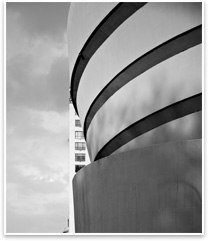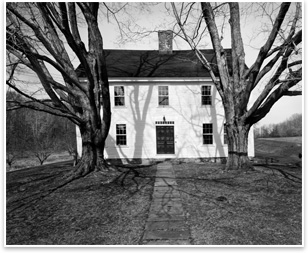AIA Partners with National Building Museum
on Trager Photography Exhibition
Both organizations share goal of educating
the public about the power of architecture

Guggenheim Museum, 1978. Philip Trager, courtesy
of the National Building Museum.
The AIA has joined forces with the National
Building Museum (NBM)
to promote the exhibition “Form
and Movement: Photographs by Philip Trager.”
During his more than 40 years as a photographer, Trager has established
himself among the masters of photographing both architecture and
dance. The Trager exhibition opened last July at the National Building
Museum, with a companion presentation now on display at AIA national
component headquarters in Washington, DC.
“The AIA is very excited for everyone to join with us as we
celebrate the first exhibition at the AIA done in partnership with
the National Building Museum,” said Chris McEntee, AIA executive
vice president/CEO, at an opening-night reception at AIA that featured
a book signing by the photographer. “We have a partnership
with the National Building Museum and we share their goal of educating
the public about the power of architecture in design and transformed
communities. The National Building Museum has such a strong competency
and reputation in exhibits and reaching the public, and the AIA has
the knowledge and expertise about architecture. It is a perfect alignment
of interest to be able to partner with the National Building Museum
on exhibits like this. We hope it is the first of many.”

Glastonbury, 1976. Philip Trager, courtesy of
the National Building Museum.
The NBM exhibition includes new work exhibited publicly for the
first time. Most of the 90 photographs in the 3,000-square-foot exhibition
are black and white platinum, gelatin silver, or Iris prints, with
the exception of Trager’s recent explorations in color. The
exhibition includes images of New England, expansive New York cityscapes,
the Italian villas of Andrea Palladio, and Paris along the Seine,
as well as depictions of modern dance.
Organized by aesthetic categories that span subject matter, the
exhibition brings to the forefront the photographer’s formalist
eye and desire to capture what he considers to be the essential character
of his subjects, whether it is a Palladian villa or a body in flight.
Light and perspective, motion and symmetry—rather than specific
buildings or dancers—are the subjects under investigation in
Form and
Movement.

West 122nd Street, 1979. Philip Trager, courtesy
of the National Building Museum.
“I had been photographing architecture when I decided that
I also wanted to photograph dancers outdoors in the natural light,” said
Trager. “The only photography of architecture that I have done
has been in the natural light, and also that is true of dancers.
All these photographs are taken as I find the structure. I try to
get what I think is the feeling and presence of the structure to
try to understand it emotionally, looking at it side to side and
up and down, and placing the camera in a way that if I went back
there 20 years later I would place it the same way.”
Form and Movement: Photographs by Philip
Trager is presented in
cooperation with the Library of Congress, which will ultimately house
the definitive archive of Trager’s work. |



